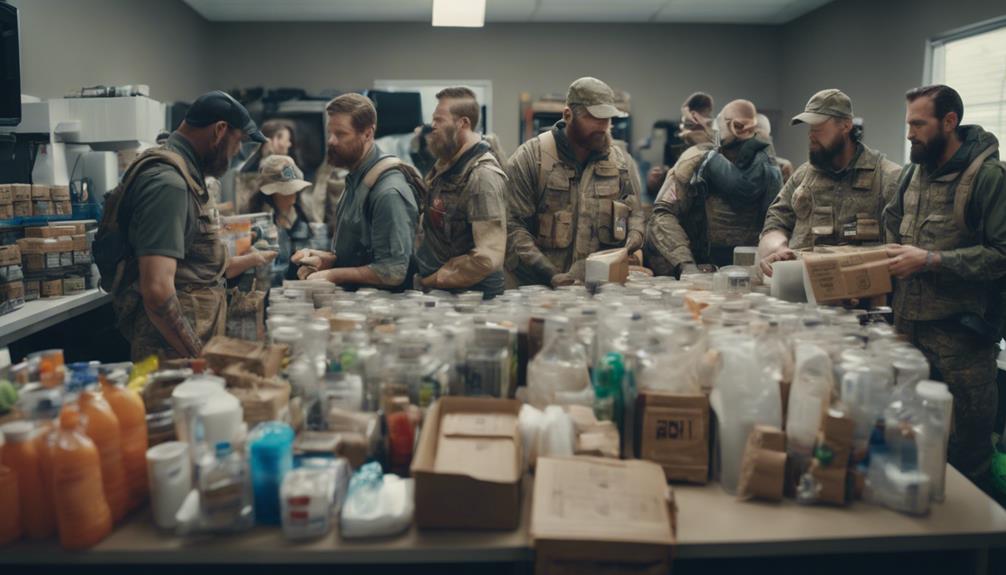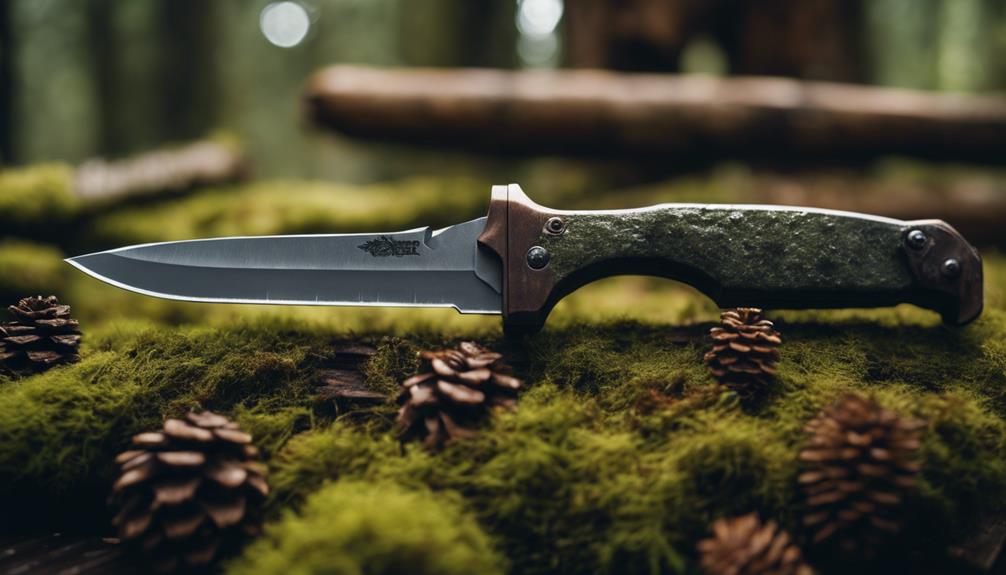Teaching kids first aid basics is a powerful way to empower them as young survivors. Start by introducing key concepts, like how to call 911 and what to say during an emergency. Use fun activities, like play doctor with stuffed animals, to reinforce learning. Role-playing helps them practice recognizing dangers and responding effectively. Encourage them to keep a first aid kit handy and explain its contents. By creating a safety plan and practicing it regularly, they'll feel more confident. Want to help them develop these essential skills further? Keep exploring effective ways to train young lifesavers.
Key Takeaways
- Introduce emergency concepts like calling 911 and identifying dangerous situations through engaging activities and role-playing scenarios.
- Teach kids basic first aid skills, such as treating minor injuries and recognizing signs of serious emergencies like severe bleeding or loss of consciousness.
- Encourage preparedness by having accessible first aid kits and memorizing important contact numbers, enhancing their confidence in handling emergencies.
- Use fun games and hands-on practice, such as "First Aid Bingo," to reinforce learning and critical thinking about emergency responses.
- Emphasize the importance of safety education, including recognizing household hazards and practicing safe emergency procedures like fire drills.
Teaching Basic First Aid Skills
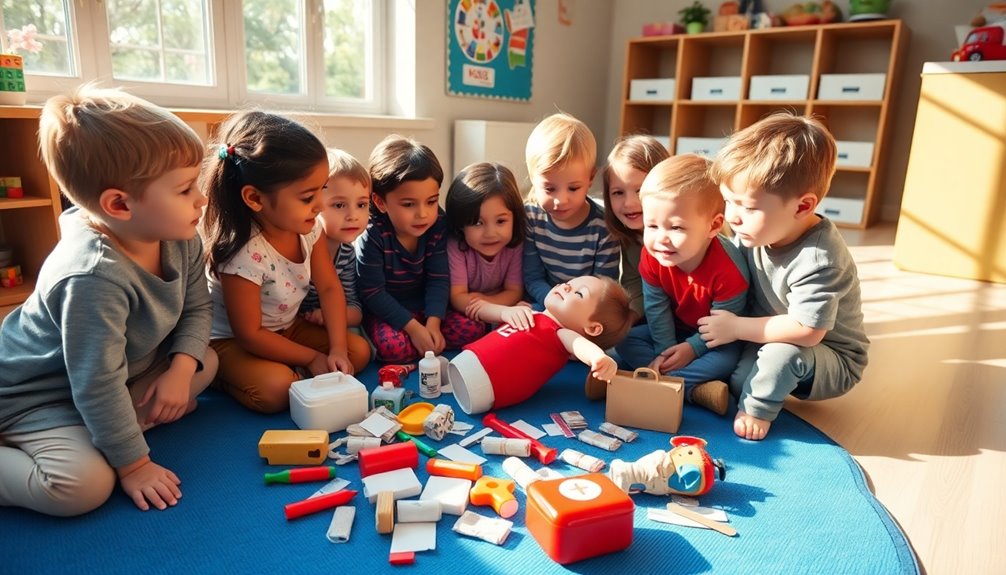
Teaching kids basic first aid skills is crucial, and it's something you can do regularly to instill confidence and knowledge. Start with toddlers and preschoolers by introducing them to emergency concepts, like calling 911. Use play doctor activities to make learning fun. Simple instructions, like "Tell an adult if someone is hurt," help them understand safety in a way that fits their cognitive level.
Incorporate hands-on practice with props like stuffed animals to demonstrate basic techniques, such as bandaging. Create role-playing scenarios where kids can apply a sling for a "broken arm" or use CPR manikins to learn proper hand placement and compressions. Games like "First Aid Bingo" can reinforce key concepts while keeping it engaging. Teaching these skills not only equips them for emergencies but also fosters a sense of community resilience.
As kids grow, teach older children and teens more advanced skills, including CPR and how to manage serious injuries. Emphasize the importance of staying calm and giving clear instructions when calling for help. Use storytelling and mnemonics like "Call, Check, Care" to make the information memorable. Tailor your approach to their readiness, ensuring they grasp these crucial skills effectively.
Recognizing Emergencies

Recognizing emergencies is essential for keeping yourself and others safe. Start by paying attention to signs of respiratory distress. If someone is breathing rapidly, struggling to breathe, or making wheezing sounds, it's critical to act quickly. Look for flaring nostrils, retractions in the chest or neck, and any bluish discoloration around the lips or face.
Next, identify bleeding emergencies. If you see severe bleeding that won't stop with direct pressure, or if the person appears pale or weak, it's a serious situation. Loss of consciousness can also indicate an emergency. Sudden unresponsiveness or prolonged unconsciousness requires immediate attention.
You should also be aware of seizures and other neurological emergencies. If someone experiences involuntary muscle contractions or loses control over their body, it's essential to stay calm and guarantee their safety. After a seizure, the person may seem confused or unable to respond. Additionally, having a basic understanding of first aid can empower you to respond effectively during these emergencies.
Recognizing these signs can make all the difference in an emergency. Stay alert and trust your instincts; your ability to identify these situations could save a life.
Calling for Help

In an emergency, knowing how to call for help can make all the difference. It's essential for you to stay calm and communicate clearly. If you need to call for help, here are some key points to remember:
- Dial 911: This is the primary emergency number in many areas. If it's unavailable, know your local emergency number.
- Stay on the line: Don't hang up until the operator tells you to. They may need more information.
- Provide clear information: Be ready to share your name, address, phone number, and details about the emergency.
- Have someone else call: If you're caring for an injured person, ask someone nearby to make the call.
- Teach contact numbers: Make sure you memorize important numbers, like a parent's cell phone or a trusted neighbor's number.
It's also good practice to post emergency numbers where they're easy to find. Community awareness of EMS functions can significantly enhance your ability to respond effectively in emergencies. Remember, reporting an emergency to a trusted adult right away can save lives. By knowing how to call for help, you're empowering yourself and others during critical moments.
Preventing Further Injury
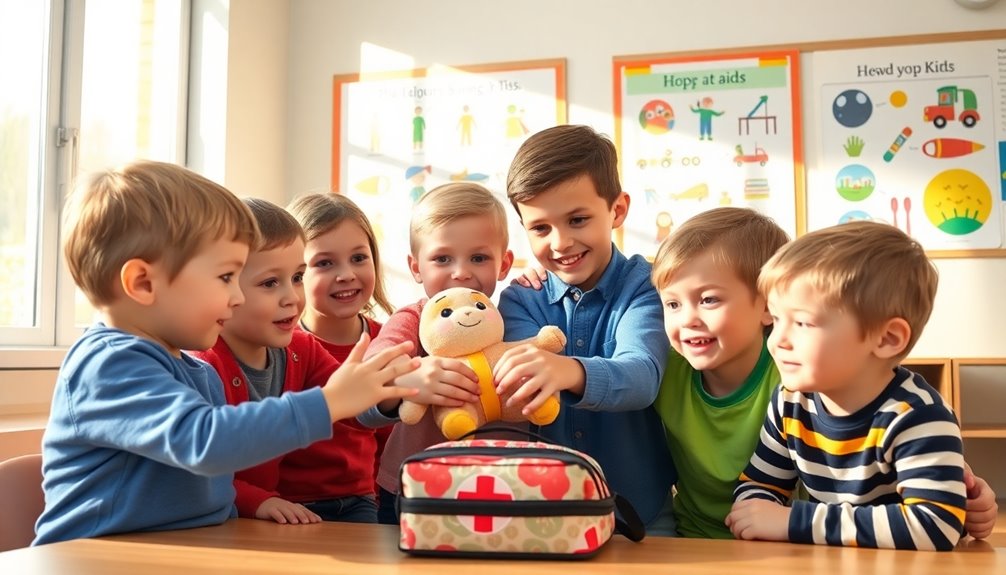
When someone gets hurt, your first priority should be to prevent further injury. Start by recognizing potential hazards in the area. Look for trip hazards, sharp objects, or hot surfaces that could cause more harm. Clear clutter and secure cords to keep the area safe. Educate yourself and others about common household dangers, like electrical outlets and toxic substances. Additionally, stabilizing the casualty's condition can help minimize the risk of further injury during the response. It's also essential to monitor environmental factors that could contribute to accidents, such as noise or overcrowding.
If it's necessary to move the injured person, make certain you do so safely. Teach others to keep the casualty's head and neck stable and avoid unnecessary movement of injured limbs. If they're unconscious but breathing, position them on their side to maintain an open airway.
Protective measures are important too. Use personal protective equipment, like gloves, when available. Keep sharp objects and hot devices out of reach, and secure heavy furniture to prevent accidents. Additionally, discuss environmental safety by creating a fire escape plan and emphasizing water safety. Always make certain vehicle safety by using proper car seats and seatbelts.
First Aid Kits and Supplies
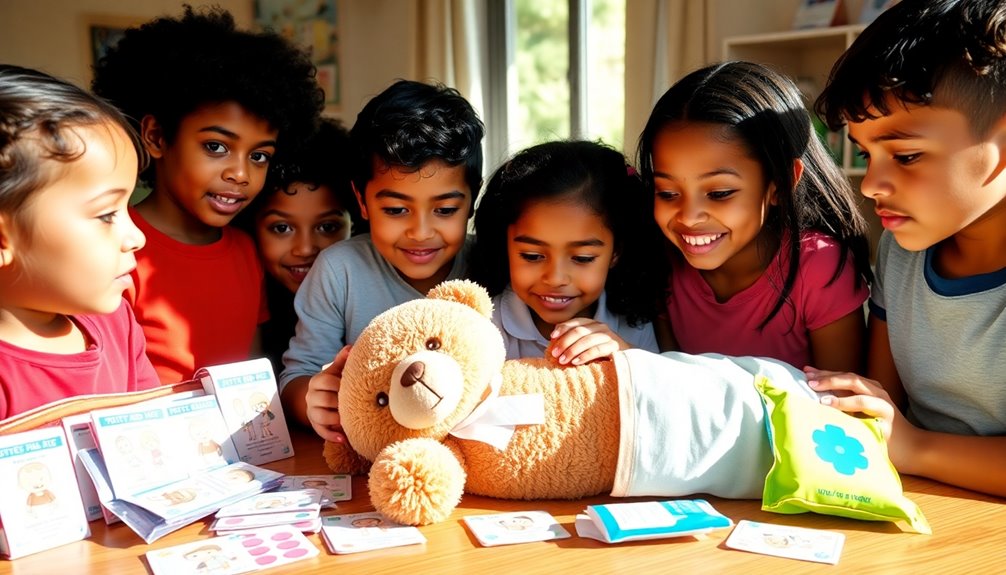
When it comes to first aid kits for kids, having the right essential components is vital. You’ll want a portable and compact design that’s easy to store and carry, ensuring you can grab it when needed. Don’t forget to include an emergency guide to help you respond quickly and effectively in any situation. Given that 2/3 of childhood deaths occur in children under age 1 due to suffocation, it’s crucial to ensure that your first aid kit is equipped to handle emergencies effectively. Having child-specific items such as pediatric medications, adhesive bandages in various sizes, and child-friendly thermometers can also be incredibly useful. It’s important to regularly check and update your first aid kit to ensure that all items are in good condition and within their expiration dates. Prioritizing emergency preparedness for children can make a significant difference in responding to unexpected situations and keeping kids safe.
Essential Kit Components
Having a well-stocked first aid kit is essential for handling minor injuries and emergencies, especially when kids are involved. You want to make sure your kit contains the necessary supplies to treat a variety of situations effectively. Here are some key components to include:
- Basic wound care items: Triangular bandages, crepe bandages, non-adhesive dressings, adhesive strips (bandaids), and gauze dressings.
- General first aid supplies: Disposable gloves (medium and large, non-latex), adhesive tape, scissors, tweezers, and a resuscitation mask or face shield.
- Medications and treatments: Antibacterial ointment, aloe vera gel for burns, antihistamines (like Zyrtec® or Benadryl®), pain relievers (such as ibuprofen or acetaminophen), and antacids. It's important to note that medications should be stored separately from first aid kits to ensure safety and proper use.
- Miscellaneous items: A thermal blanket, a notepad and pencil, plastic bags, hand sanitizer, masks, a cold pack for bumps, and a thermometer.
Portable and Compact Design
A well-stocked first aid kit is only as effective as its portability and design. When you're on the go, you need a compact kit that's easy to carry. The Children's First Aid and CPR Kit, with dimensions of 7.5" x 5.5", weighs under 500 grams, making it lightweight enough to fit in your car, backpack, or even a diaper bag. Mini kit options are also available, perfect for strollers or purses.
The durable, rip-resistant fabric bag features organized compartments with a color-coded labeling system, allowing you to quickly identify supplies. Numbered labels help you keep track of what needs replacing, guaranteeing you're always prepared. This versatile kit is great for various outings, whether it's a trip to the park or a family camping adventure. Additionally, knowledge of fire safety can be life-saving, as fires can engulf a house within 5 minutes, making having a first aid kit essential.
Made with child-safe, latex-free components, the supplies are designed to be gentle on sensitive skin. Waterproof bandages and rust-resistant stainless steel tools guarantee durability. With its thoughtful design, you can confidently address everyday emergencies while enjoying your outings, knowing you have a reliable first aid kit at your fingertips.
Emergency Guide Inclusion
In emergencies, having a well-rounded first aid kit is vital for addressing a variety of situations quickly and effectively. By including the right supplies, you'll be prepared to respond to injuries and illnesses when they occur. Here are some vital items you should have in your first aid kit:
- Band-Aids in assorted sizes
- Gauze pads and rolled gauze
- Instant cold pack (disposable)
- Adhesive tape
- Personal protective items like plastic gloves
Additionally, it's important to include medications and topical treatments. Keep acetaminophen, ibuprofen, and antibiotic cream handy. Don't forget an emergency blanket and a CPR mask to guarantee you're prepared for serious situations. Having first aid kits in multiple locations ensures that help is always within reach.
Lastly, equip your kit with information and guides. Have emergency phone numbers, a first aid book, and simple instructions for common injuries. This way, you'll feel more confident while helping others in need.
Always check your kit regularly to restock supplies and replace expired items. With a well-equipped first aid kit, you're empowering yourself and those around you to handle emergencies safely and effectively.
Role-Playing and Situational Awareness
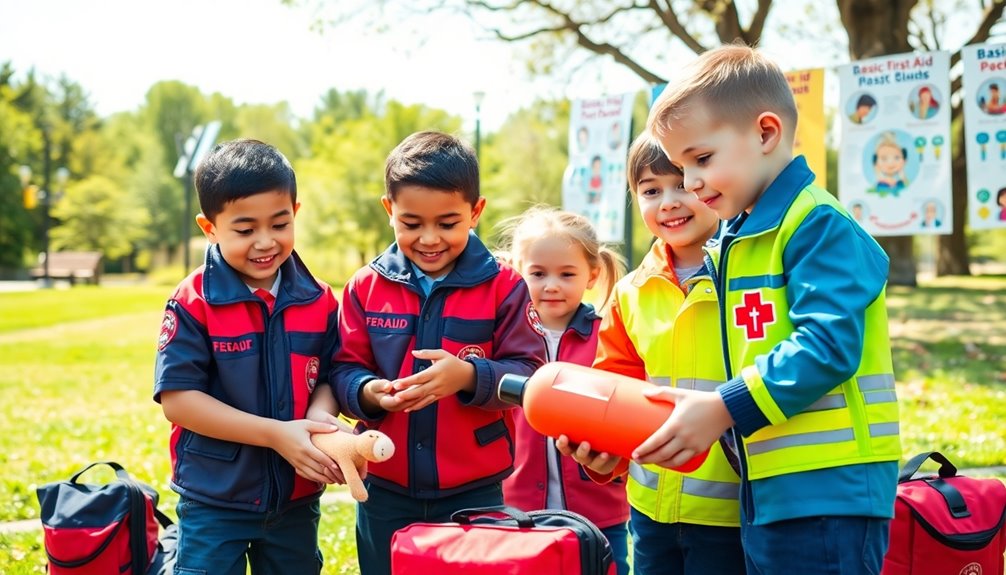
Role-playing emergency scenarios can really help you and your child practice first aid skills in a fun way. By acting out situations like recognizing a dangerous situation or treating a minor injury, kids learn how to respond effectively when it counts. This hands-on approach not only builds confidence but also reinforces the importance of staying aware of their surroundings. Additionally, engaging in role-playing activities encourages interactive learning and helps children develop critical thinking skills.
Emergency Scenario Practice
Practicing emergency scenarios through role-playing helps kids learn how to respond effectively in various situations. By acting out different emergencies, you can teach them the importance of staying calm and making informed decisions. Here are some effective strategies to implement:
- Divide kids into groups to act out scenarios like a flash flood or a minor injury.
- Assign roles and encourage them to practice responses for emergencies such as choking, bleeding, or burns.
- After each scene, discuss the group's actions to identify what worked well and what could improve.
- Encourage them to re-enact the scenario, correcting mistakes from their first attempt to reinforce learning. Additionally, remind them to follow safety guidelines to ensure their well-being during practice.
- Incorporate evacuation drills and shelter-in-place exercises for natural disasters, helping them understand what to do if separated from family or friends.
Through these activities, kids not only gain practical skills but also develop situational awareness. They'll learn to recognize common emergencies and understand the need for a well-stocked first aid kit. Additionally, engaging in these practices aligns with the importance of lifesaving skills taught in the CPR & First Aid in Youth Sports Training Kit. By engaging in these practices, you empower them to handle real-life situations confidently and responsibly.
Recognizing Dangerous Situations
Kids can enhance their emergency response skills by learning to recognize dangerous situations in their everyday lives. Start with crossing the street safely. Always look both ways, use crosswalks, and avoid distractions like phones. Holding an adult's hand is vital, and darting into the street is a big no-no.
Next, teach them about strangers. Role-play scenarios where a stranger approaches, emphasizing they shouldn't engage or go anywhere with unfamiliar people. Staying close to trusted adults in public is essential. Help them identify trusted authorities, like police officers or teachers, and discuss what to do if someone tries to lure them away.
If they ever get lost, remind them to find a trusted adult immediately, such as a police officer or store employee. It's smart to stay in one place and not wander off. Encourage them to memorize their home address and phone number. Additionally, instilling situational awareness can empower children to make informed decisions and navigate challenges more effectively.
Frequently Asked Questions
What Should I Include in a Home First Aid Kit?
When you're putting together a home first aid kit, include essential items like sterile gauze pads, adhesive bandages, antiseptic wipes, and adhesive tape. Don't forget tweezers, scissors, a thermometer, and disposable cold packs. Stock up on medications such as acetaminophen, ibuprofen, and antihistamines. Keep antibiotic ointment, hydrocortisone cream, and plastic gloves handy too. Also, make sure you have emergency phone numbers and a first-aid manual for quick reference.
How Can Kids Practice First Aid Safely?
Imagine you're a brave knight, ready to rescue your stuffed animals from peril! To practice first aid safely, you can role-play by pretending to treat their "injuries" with fun bandages. Use props like toys or mannequins to demonstrate techniques. Play games like "First Aid Bingo" to learn while having fun. Don't forget to practice those skills regularly, and always have an adult supervising your heroic missions to guarantee you're learning correctly!
At What Age Can Children Learn First Aid Skills?
You can start teaching first aid skills to children as young as age 6. At this age, they begin to understand the importance of calling for help and recognizing emergencies. As they grow, around age 11, they can learn CPR and basic life support. By their teenage years, they can master advanced skills like using an AED and controlling bleeding. Early education sets the foundation for responsible, confident decision-making in emergencies.
How Do I Teach Kids About Personal Safety?
Picture a child confidently walking in a park, surrounded by sunlight and laughter, yet aware of potential dangers. To teach kids about personal safety, practice skills in fun, supervised settings. Role-play emergency scenarios, like calling 911 or responding to strangers. Encourage walking with friends and familiarizing them with safe routes. Reinforce the importance of trusting their instincts and checking with adults. With your guidance, they'll feel empowered to navigate their world safely.
What Are the Signs of Dehydration in Children?
When you're checking for dehydration in children, look for a dry or sticky mouth, crankiness, or fewer tears when they cry. You might notice sunken eyes or a soft spot on their head if they're very young. If they're less playful, have a rapid heartbeat, or seem lightheaded, that's a concern. Pay attention to how many wet diapers they have; fewer than usual can indicate dehydration. Always keep an eye on their overall alertness.
Conclusion
By learning basic first aid skills, you’re not just preparing for emergencies; you’re empowering young survivors to take action in critical moments. Recognizing an emergency versus a minor scrape can mean the difference between panic and calm. Calling for help may seem intimidating, but it’s an essential lifeline. With a well-stocked first aid kit, you’re ready for anything. So, embrace the power of knowledge and watch confidence bloom in your young ones, turning fear into strength. Practice simple but essential first aid techniques, such as bandaging wounds and performing CPR, can make a life-changing impact. These skills not only provide immediate relief but also foster a sense of control and capability in children. By teaching them these crucial first aid techniques, you are equipping them with the tools they need to respond confidently in emergency situations.





